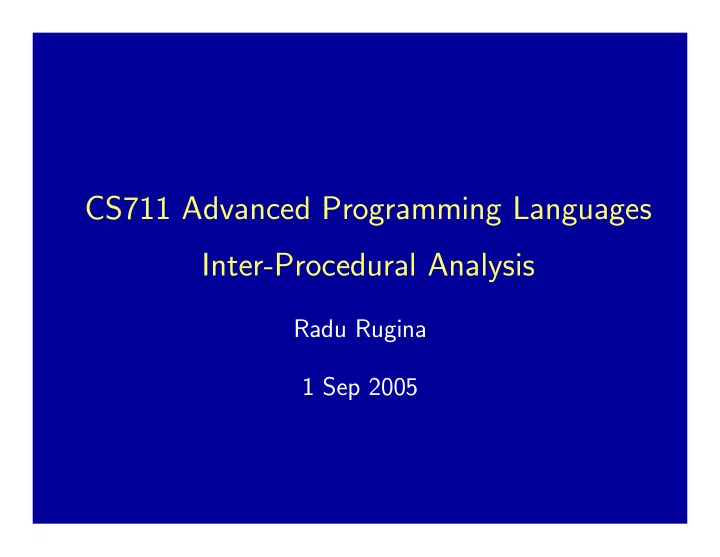

CS711 Advanced Programming Languages Inter-Procedural Analysis Radu Rugina 1 Sep 2005
Inter-Procedural Analysis • Standard intra-procedural dataflow analysis: – Build flow graph, propagate dataflow facts – Assumes no procedure calls – Or uses worst-case assumptions about procedure calls • Inter-procedural analysis – Analyze procedure interactions more precisely – Difficult to do it efficiently and precisely CS711 Inter-Procedural Analysis 2
The problem P() Q() call Q() • Transfer function of call = analysis of callee ’ s body • Two quick ‘ solutions ” to this problem CS711 Inter-Procedural Analysis 3
Quick Solution 1: Inlining • Inline callees into callers – End up with one big procedure – CFGs of individual procedures = duplicated many times • Good: it is precise – distinguishes between different calls to the same function • Bad: exponential blow-up, not efficient main() { f(); f(); } f() { g(); g(); } g() { h(); h(); } h() { ... } • Bad: doesn ’ t work with recursion CS711 Inter-Procedural Analysis 4
Quick Solution 2: Extend CFG • Build a “ supergraph ” = inter-procedural CFG • Replace each call from P to Q – An edge from point before the call (call point) to Q ’ s entry point – An edge from Q ’ s exit point to the point after the call (return pt) – If necessary, add assignments of actuals to formals, and assignment of return value • Good: efficient – Graph of each function included exactly once in the supergraph – Works for recursive functions (although local variables need additional treatment) • Bad: imprecise, “ context-insensitive ” – The “ unrealizable paths problem ” : dataflow facts can propagate along infeasible control paths CS711 Inter-Procedural Analysis 5
Unrealizable Paths P() Q() R() read(x) x = z call Q() y = x call Q() print(y) print(1) CS711 Inter-Procedural Analysis 6
Unrealizable Paths P() Q() R() read(x) x = z call Q() y = x call Q() print(y) print(1) CS711 Inter-Procedural Analysis 7
DFA Review • CFG with nodes n ∈ N • Dataflow facts: d ∈ L (lattice) • Transfer function: � n � : L → L • MFP (maximal fixed point) solution = greatest solution of: X(n) = d 0 , if n = entry X(n) = � { � m � X(m) | m ∈ preds(n) } • MOP (meet-over-paths) solution: MOP(n) = � { ( � p k � o … o � p 1 � o � p 0 � ) (d 0 ) | p 0 p 1 … p k is a path to n } • Safe: MOP � MFP • Precise if transfer functions are distributive: MOP = MFP CS711 Inter-Procedural Analysis 8
Inter-Procedural DFA • Consider the supergraph • Additionally, for each call i : – label call → entry edge with ( i – label exit → return edge with ) i • Consider only valid paths through the supergraph: ε | matched ::= matched ( i matched ) i valid ::= valid ( i matched | matched • MOVP = meet-over-valid-paths MOVP(n) = � { ( � p k � o … o � p 1 � o � p 0 � ) (d 0 ) | p 0 p 1 … p k is a valid path to n } CS711 Inter-Procedural Analysis 9
Valid Paths P() Q() R() read(x) x = z ( 1 ( 2 call Q() y = x call Q() ) 1 ) 2 print(y) print(1) CS711 Inter-Procedural Analysis 10
IFDS Problems • Finite subset, distributive problems: – Lattice: L = 2 D for some finite set D – Partial order is ⊆ , meet is ∪ – Transfer functions are distributive • A precise, efficient solution to IPA for such dataflow problems 1: an encoding of transfer functions 2: a formulation of the problem using CFL reachability 3: an efficient CFL reachability algorithm for the matched parentheses grammar CS711 Inter-Procedural Analysis 11
Transfer Function Encoding • Enumerate all input space and output space • Represent functions as graphs with 2(D+1) nodes • Use a special symbol “ 0 ” to describe empty sets D = { a, b, c } • Example: f (S) = (S – { a } ) ∪ { b } 0 a b c 0 a b c CS711 Inter-Procedural Analysis 12
Exploded Supergraph • Exploded supergraph: – Start with supergraph – Replace each node by its graph representation – Add edges between corresponding elements in D at consecutive program points • CFL reachability: – Finding MOVP solution is equivalent to computing CFL reachability over the exploded supergraph using the valid parentheses grammar. CS711 Inter-Procedural Analysis 13
CS711 Inter-Procedural Analysis 14
CS711 Inter-Procedural Analysis 15
The Tabulation Algorithm • Worklist algorithm, start from entry of “ main ” • Keep track of: – Path edges: matched paren paths from procedure entry – Summary edges: matched paren call-return paths • At each instruction: – Propagate facts using transfer functions; extend path edges • At each call: – Propagate to procedure entry, start with an empty path – If a summary for that entry exits, use it • At each exit: – Store paths from corresponding call points as summary paths – When a new summary is added, propagate to the return node CS711 Inter-Procedural Analysis 16
Complexity • Polynomial-time complexity – Recall that inlining is exponential • Inter-procedural: O(ED 3 ) – E = number of edges – D = size of the dataflow set • Locally-separable (bit-vector): O(ED) CS711 Inter-Procedural Analysis 17
Experiments CS711 Inter-Procedural Analysis 18
Recommend
More recommend